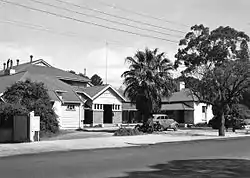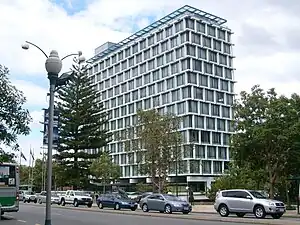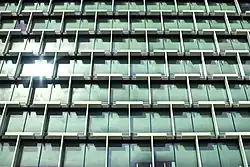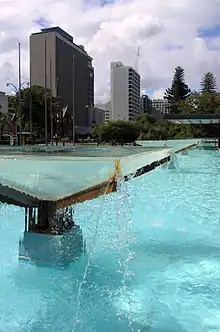Council House, Perth
Council House is a 13-storey office building on St Georges Terrace in Perth, Western Australia. Located beside Stirling Gardens and Government House in the city's central business district, the 49.8-metre (163 ft) building was designed by Howlett and Bailey Architects and opened by Queen Elizabeth II in 1963, after Perth hosted the 1962 British Empire and Commonwealth Games. For most of its history, it has served as the headquarters for the City of Perth.
| Council House | |
|---|---|
 Council House | |
| General information | |
| Type | Office building |
| Location | 27–29 St Georges Terrace, Perth, Western Australia |
| Coordinates | 31°57′24″S 115°51′39″E |
| Construction started | October 1961 |
| Completed | 1963 |
| Cost | £1.5 million |
| Owner | City of Perth |
| Height | |
| Roof | 49.8 m (163 ft) |
| Technical details | |
| Floor count | 13 |
| Design and construction | |
| Architect(s) | Jeffrey Howlett & Don Bailey |
| Main contractor | J. Hawkins and Son |
| Type | State Registered Place |
| Designated | 8 December 2006 |
| Reference no. | 2097 |
| References | |
| [1][2][3][4] | |
Built in a modernist style, the building has been the subject of vigorous public debate about its heritage value. Some parties, such as the Royal Australian Institute of Architects, consider the building to be an important example of modernist architecture in the city, whilst others consider it ugly. These conflicting views led to animosity in the 1990s, when the State Government refused to heritage list the property, and instead recommended its demolition. Despite this, the City of Perth opted to renovate the tower and keep it as its headquarters. Following this, the building was admitted to the State's Heritage Register.
Prior site history
The site was originally home to the Colony's governing Legislative Council in a building which came to be known as the Old Government Offices or Public Offices.[5] The building was designed by Acting Civil Engineer Henry Reveley in August 1836 after he was asked to prepare plans for public offices on the site.[6] A call for tenders was made, and the tender accepted was for £1,833, well above the £1,200 maximum specified in the call for tenders.[6] Payment was delayed until February 1839.[6]

The Public Offices stood 10 metres (33 ft) back from St Georges Terrace.[6] The Legislative Council occupied the building until 1870, when it moved to a chamber adjoining the new Perth Town Hall. The Legislative Council returned to the building in 1890 after the newly formed Legislative Assembly took over that chamber.[7] In the 1890s, the building became a post office,[2] before being taken over by the Department of Agriculture,[5] and the building continued to be used as public offices until 1961.[6] Additions to the building in the 1930s[2] included a second storey, which contained a Legislative Council room and offices for senior public servants.[6] Showing its age, the building eventually became what was described as a "rat-infested hell-hole".[8]
The Perth City Council had been based from 1871 in the Perth Town Hall, then in 1925 moved to offices in Murray Street.[9] The site of the Public Offices on St Georges Terrace was chosen as the site for a new home for the Perth City Council in 1954.[9] Immediately south of the Public Offices building stood the Soldiers' Institute building.[2] This building was taken over from the Returned Soldiers' League by the ABC[10] in 1937 for its 6WF radio studio.[11]
Competition and construction
With the news that Perth would be hosting the 1962 British Empire and Commonwealth Games, Perth City Council in 1959 launched an international competition to design its new building.[9] The brief in the competition was to design a "creative building that marked where Perth was at the time"[12] and have the building ready in time for the opening of the Commonwealth Games.[13]
Following the competition announcement,184 architects registered, with 61 designs eventually entered into the competition,[14] including one by Jeffrey Howlett and Don Bailey[3] from the Melbourne architectural firm Bates, Smart and McCutcheon.[2] The jury assessing the competition entries, which included architect Harry Seidler,[15] described the Howlett-Bailey plan as "a remarkably simple solution to a complex problem"[15] and declared them winners of the competition.[16]
The ABC moved to new premises on Adelaide Terrace in 1960[11] when the Council House site was taken over by the Perth City Council for construction to begin.[10] Both the Public Offices and Soldiers' Institute buildings were demolished to make way for the redevelopment.
Excavations for construction of the building's foundations started in October 1961 and the first concrete pour occurred in November 1961.[2] The building was not completely finished by the time Perth hosted the Commonwealth Games in November 1962, however the builders rushed to finish the ground, eighth, and 10th floors in time so that foreign dignitaries could be entertained in the reception areas.[17] Following the Games, the fit-out of the building was finished in March 1963,[2] and on 25 March 1963 Queen Elizabeth II officially opened Council House, unveiling a 2.4-metre (7.9 ft) tall ceremonial plaque set in granite from the original 1817 Waterloo Bridge in London.[2]
Construction of Council House was performed by J. Hawkins and Son Pty Ltd, and cost £1.5 million.[2] It was the first building in Perth to use complete window walling.[16] In order to reduce the heat entering the building through these full-height windows, the building used internal blinds and external sun-breakers.[18] When the building was opened, all Perth City Council activities were moved there.[19]
Part of Howlett and Bailey's plans for the complex included the extension of Terrace Road westwards across the sites of the Old Court House and the Supreme Court, but this was never done.[16] Also part of their plan was the construction of an elliptical auditorium called the "Public Suite" behind Council House; the plan to build this was dropped after the completion of Council House,[15] with the design reformulated by Howlett and Bailey and the building eventually built on the opposite side of Government House as the Perth Concert Hall.[20][21]
1990s refurbishment and heritage listing

The building continued to serve as the headquarters for the Perth City Council from its completion until 1994, when it was vacated to allow for the removal of asbestos[22] which had been used to insulate the building's steel frame.[23] The Council moved to office space in the Westralia Square building.[24]
In 1994, Commissioners appointed by the State to oversee the break-up of the Perth City Council voted to demolish the building.[22] At the time, refurbishment costs were estimated to run to $42 million.[24] The State Government's plan was to demolish the building and extend Stirling Gardens right across the site to beside Government House,[3] as part of a broader plan entitled "Perth – A City for People" which also included the Northbridge Tunnel, the sinking of Riverside Drive, and the housing of Supreme Court and District Court under the one roof.[25] The State Government suggested that the Council move into the Old Treasury Building across St Georges Terrace,[26] for which they offered an incentive of $30 million.[27]
Significant public debate ensued about whether the building should be kept. Those prominent in the fight to save the building included Bill Warnock,[28] architect Ken Adam,[29] and the Royal Australian Institute of Architects.[30] Others said it was "out of date, unattractive, and out of step" with the older heritage buildings which surround it.[31] Graham Kierath, the Minister for Heritage, also refused to place the building on the WA Register of Heritage Places, despite calls from the Heritage Council and the National Trust to do so.[32] This decision "stunned" the Institute of Architects.[33]
Despite the recommendation for demolition, in late 1995, the councillors of the newly formed City of Perth had a feasibility study carried out into whether Council House could be refurbished.[22] This feasibility study was carried out by Architects Cox Howlett and Bailey, of which one of the partners was the son of original designer Jeffrey Howlett,[22] and cost $100,000.[24] The study indicated that the building could be economically refurbished, and in December 1996 the Council unanimously agreed to press ahead with refurbishment plans,[23] removing its asbestos and building an underground car park at the rear of the site.[24] The decision to refurbish was helped by the fact that interest rates at the time were so low that it was cheaper to service a loan than to pay rent.[22] At the time, the refurbishment was expected to cost around $26 million.[24]
The new 95-bay car park at the rear of the building required the removal of a New Zealand Kauri Pine estimated to be up to 150 years old,[34] and was described by John Cowdell, a Labor MLC, as a "disgrace" which would undermine the heritage value of the precinct.[35] There was also some concern expressed that the refurbishment might cause the building to lose heritage value through the updating of its interiors.[31]

The contract to refurbish the building was won by John Holland Group, the construction company of Janet Holmes à Court, on 29 July 1997, at a price of $25.3 million.[36] The architect for the refurbishment was Geoffrey Clough of Peter Hunt and Daryl Jackson Architects.[15][22] The building was "stripped back to bare bones" and the tiny tiles coating the building's distinctive "T"-shaped fins were removed, repaired, and re-glued to the surface.[22] The refurbishment also involved the construction of a new "Lord Mayoral space and reception area" on the eleventh floor (formerly a plant level),[2] the full enclosure of the ground floor (which had previously been partially open to the elements)[2] and the replacement of gold Venetian blinds which had been a feature of the building in the past.[15]
The City of Perth moved back to Council House in February 1999[17] and placed three unused floors of Council House for lease.[37] The refurbishment was widely considered a "qualified success",[38] with the building "handsomely restored".[30]
The 2001 state election resulted in a change of government, with the Labor Party returning to power. The restored building was finally placed on the interim heritage list by Heritage Minister Michelle Roberts on 5 March 2006.[39] Former Heritage Minister Graham Kierath, who had resisted the nomination in the 1990s, attacked the decision to list the building as pandering to left-wing supporters.[40] The Heritage Council of Western Australia recommended on 17 November 2006 that the listing of the building go ahead.[41] The building was entered as a permanent entry on the Heritage Register on 8 December 2006.[42]
While the building is different from our traditional notion of heritage, Council House will be as important to future generations as many of our colonial buildings that are considered priceless to the community today.
Design and reaction


Council House is constructed from concrete-encased steel frame, with lifts and service rooms located at its eastern end and a fire escape stairwell at its western end.[2] Level 9 houses the distinctive circular Council Chamber, which features wood panelling and has been restored to largely its original state in the 1990s refurbishment (by contrast to most of the other levels of the building).[2] The building is almost completely clad with glass, which led to criticism about its excessive air conditioning costs.[39] The glass exterior of the building has T-shaped white sunbreakers superimposed in an alternating pattern across the building, coated with fine mosaic tiles. With the newly enclosed top floor, the building now has 13 levels above ground.[1]
The building, which was the favourite creation of its designer Jeffrey Howlett,[43] has been called the most important example of modernist architecture in Perth[43] and "one of the State's modernist icons".[44] The building[17] has been described as demonstrating "modernist aspirations" from the Bauhaus school,[3] exuding "brutalist warmth".[45] Stephen Neille, the Chair of Architectural Design at Curtin University, described it as reflecting Perth of that time: a city "brimming with confidence and consciously promoting itself to the world as a modern city".[46] Adrian Iredale, from architects Iredale Pederson Hook, described the building as "simultaneously elegant and heavy and introducing poetry through the repetitive system of sun shading, the big Ts that hover in front of the facade on all sides."[47]
The building has divided the public over the years, with some branding the building an "eyesore"[3] and a "hideous folly",[48] whereas others considered it a "classic example of 1960s architecture and an important reminder of Perth's past"[48] and a "unique building".[39] It has been suggested by Associate Ralph Hoare from the Australian Institute of Architects said the building should never have been built on St Georges Terrace, having been built in the "wrong place".[26]
When it was built, it reflected this great optimism in WA, this was the sixties. I really think that's a superb building as it still mirrors the Perth of its time.
— architect Dick Donaldson[49]
LED lighting
The outside of the building was fitted with over 22,000 LED lights which was officially turned on on 7 April 2010. The LEDs located on the roof, "T" window structures, and bulkheads are able to be individually computer controlled and coloured. The lights were installed at a cost of $1.08 million.[50]
References
- "Council House, Perth". Emporis. Archived from the original on 10 March 2007. Retrieved 21 November 2008.
- "Register of Heritage Places - Assessment Documentation" (PDF). heritage Council of Western Australia. 8 December 2006. Archived from the original (PDF) on 29 July 2008. Retrieved 21 November 2008.
- Gould, Vanessa (2 August 1997). "The Thirty-year Itch". The West Australian. p. 3.
- "Council House, Perth". SkyscraperPage.com. Skyscraper Source Media Inc. Retrieved 21 November 2008.
- Seddon, George; David Ravine (1986). A city and its setting: images of Perth, Western Australia. Fremantle: Fremantle Arts Centre Press. p. 96. ISBN 0-949206-08-3.
- Dunn, Frank (20 July 2008). "Now and then – Henry Reveley". Sunday Times. p. 10.
- David Black, ed. (1991). The House on the hill: a history of the Parliament of Western Australia 1832–1990. Western Australian Parliamentary History Project. Perth, Western Australia: Parliament of Western Australia. p. 66. ISBN 0-7309-3983-9.
- Cornish, Patrick (17 December 2003). "Obituaries – Fortune be my name". The West Australian.
- Hunter, Tamara (27 November 1999). "Council House Born in Chaos". The West Australian. p. 12.
- Robb, Trevor (25 January 2001). "Humble Beginnings". The West Australian. p. 12.
- Kent, Melissa (5 June 2004). "Aunty ABC turns 80 with grace". The West Australian. p. 17.
- Jacobs, Marsha (5 May 2005). "Kerr looks to develop understanding". WA Business News.
- Hunter, Tamara (27 November 1999). "History of Chaos Behind Perth's Council House". The West Australian. p. 12.
When official guests in Perth for the 1962 Commonwealth Games were feted in style in the newly built Council House, they had no idea that around them chaos still reigned. Under a punishing deadline to finish the building in time for the opening of the Games by the Duke of Edinburgh, builders only had time to fit out only the ground and reception floors.
- Matthews, Leonie; Sully, Nicole (2019). Civic Visions: Council House 1954–1963. St Lucia: University of Queensland. p. 1. Retrieved 24 June 2022.
- Ward, Peter (19 March 1999). "Shock of the newly old". The Australian. p. 40.
- Hocking, Ian (c. 1987). Perth—the building challenge. Perth: The Master Builders' Association of Western Australia. p. 27. ISBN 0-9598935-3-9.
- Tickner, Liz (10 February 1999). "Council House Back in the Frame". The West Australian. p. 1.
- Molyneux (1981). Ian Molyneux (ed.). Looking around Perth: a guide to the architecture of Perth and surrounding towns. Royal Australian Institute of Architects (W.A. Chapter). p. 72.
- Tickner, Liz (12 December 1998). "Background: History of the Town Hall 1860–1867". The West Australian. p. 54.
- London, Geoffrey (March–April 2006). "Vale Jeffrey Howlett 1928–2005". Architecture Australia. Architecture Media Pty Ltd. Archived from the original on 31 July 2008. Retrieved 21 November 2008.
- Morgan, Clare (7 April 1998). "Work on Concert Hall Recognised". The West Australian. p. 34.
- Minchin, Dan (11 November 1998). "Council House Still Offers Strong Views". The West Australian. p. 61.
- Spencer, Fran (31 March 1999). "Law Firm Completes Council House Moves". The West Australian. p. 65.
- Duffy, John (27 December 1996). "$30m Facelift For Council House". The West Australian. p. 27.
- Buggins, Anne (25 July 2003). "Guru hits comfort zone". The West Australian.
- Callaghan, Ruth (12 February 1997). "Tenders To Be Called For New Treasury Uses". The West Australian. p. 63.
- Radsien, Peta (11 December 2000). "What Is Heritage?". The West Australian. p. 7.
- Rasdien, Peta (23 March 2001). "Perth Passion Leads To Planning Plaudit". The West Australian. p. 9.
- Peace, Bronwyn (21 June 2003). "Award for City Vision architect". The West Australian.
- Staff writer (30 January 2002). "The tall copy syndrome". The Australian. p. 13.
- Callaghan, Ruth (26 February 1997). "Renovation Brings New Life To Older Buildings". The West Australian. p. 64.
The award-winning building has been criticised by many Perth residents as out of date, unattractive, and out of step with its older neighbours, the Weld Club, the old Treasury building and Government House. Letters to The West Australian have called it "...the most dreadful building on God's Earth" and "an ugly monstrosity".
- Duffy, John (29 May 1997). "Kierath Rules Out Council House Listing". The West Australian. p. 3.
- Duffy, John (20 September 1997). "Kierath Under Attack Over Council House". The West Australian. p. 40.
- Duffy, John (26 May 1997). "Old Tree To Make Way For Carpark". The West Australian. p. 22.
- Crawford, Hal (7 May 1997). "Planned Carpark A Disgrace, Says MLC". The West Australian. p. 46.
- Duffy, John (30 July 1997). "Council House Job Put At $25m". The West Australian. p. 24.
- McIlwraith, John (1 August 1997). "Resources tenants fail to fill CBD". The West Australian. p. 35.
- Ward, Peter (5 July 1999). "Old before their time". The Australian. p. 17.
- Quartermaine, Braden (5 March 2006). "House full of heritage". Sunday Times. p. 19.
- James, Suzannah (6 March 2006). "Kierath attacks interim heritage listing for Council House". The West Australian. p. 6.
- Parker, Gareth (18 November 2006). "Council House for heritage protection". The West Australian. p. 7.
- "Register Listings". Heritage Council of Western Australia. Archived from the original on 29 July 2008. Retrieved 21 November 2008.
Date: 08/12/2006 Status: Permanent
- Parker, Gareth (24 December 2005). "Death of architect who helped build modern image of Perth". The West Australian. p. 14.
- Snell, Todd (3 April 1998). "Monitoring young inventiveness". The Australian. p. 15.
- Hatch, Daniel (18 October 2008). "Landmarks 'cheap, ordinary'". The West Australian. p. 9.
- O'Sullivan, Peta (11 March 2007). "City needs a facelift". Sunday Times. p. 4.
- Robinson, Gail (17 December 2006). "The next step". Sunday Times. p. 4.
- Hunter, Tamara (17 May 1999). "A Tribute To Perth As We Were". The West Australian. p. 34.
- Barrass, Tony (2 October 2004). "Weekend Extra – Buildings that talk to us". The West Australian. p. 2.
- "Old Perth icon seen in 20,000 new lights". The West Australian. 8 April 2010. Archived from the original on 13 September 2012. Retrieved 25 May 2010.
Further reading
- Brew, Peter (1992). Markham, Michael (ed.). Jeffrey Howlett : Architectural Projects. Nedlands, WA.: School of Architecture, University of Western Australia. ISBN 0864222254.
- Darbyshire, Jo, ed. (2013). Council House : 50 years : 1963-2013. Perth: City of Perth. ISBN 9780980851359. Archived from the original on 20 April 2013.
- Lewi, Hannah. 'Paradoxes in the Conservation of Modernism' in Henket, and Heynen. Back from Utopia : The Challenge of the Modern Movement. Rotterdam: 010 Publishers, 2002.
- Matthews, Leonie; Sully, Nicole (2019). Civic Visions: Council House 1954–1963. St Lucia: University of Queensland. Retrieved 15 January 2020.
External links
- Emporis page for the building
- SkyscraperPage page for the building
- Heritage Register of Western Australia entry
- State Library of Western Australia Pictorial Collection:
- Public Offices
- Council House
- Council House under construction
- 50 Years Council House 1963 – 2013 – City of Perth
- "Civic Visions: Council House 1954–1963 [Exhibition]". Visit Perth. City of Perth. Archived from the original on 15 January 2020. Retrieved 15 January 2020.